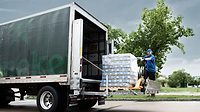Avoiding Rear-End Collisions
David Kolman
A solid topic for a driver safety meeting is avoiding rear-end collisions. They account for the largest portion of accidents on the road today. Often, this type of collision creates a chain reaction, leading to even more damage and possible injury.
A collision into the rear of a vehicle is almost always
preventable, say traffic safety professionals. There
are two types of rear-end crashes: “lead vehicle stationary” or
“lead vehicle moving.” The incidence of the crashes when lead
vehicle is stationary occurs at least twice as often as a moving lead
vehicle crash, according to the Intelligent Vehicle Initiative (IVI).
IVI’s data further indicates that driving task
errors account for the largest percentage of contributing factors for
rear-end collisions. It categorizes driving task errors as:
Recognition errors (inattention, distraction and misperception).
Decision errors (driver chooses an improper action to avoid a crash).
Performance errors (driver brakes too lightly, freezes, over-steers, etc.).
Recognition errors (inattention, distraction and misperception).
Decision errors (driver chooses an improper action to avoid a crash).
Performance errors (driver brakes too lightly, freezes, over-steers, etc.).
Other research points to the main cause of rear-end
collisions as drivers failing to detect slowed or stopped traffic, as well as not leaving sufficient distance
between their vehicle and the vehicle in front to stop in time when there
is a sudden and unexpected stop of the lead vehicle. This occurs most often
at intersections, grade crossings, passenger stops and when slowing in
preparation for turns.
Traffic safety professionals say there are several
keys to preventing rear-end collisions. One is to continually scan the road
ahead, keeping an eye out for potential traffic problems, adjusting
one’s driving in changing conditions and being prepared to react.
Another is to try to anticipate the actions of other drivers, but to never
presume to know what another driver will do.
Maintaining an adequate following distance is one more
key to preventing a rear-end collision. For normal driving circumstances,
the National Safety Council (NSC) recommends a minimum three-second spacing
between vehicles.
This is done by watching the vehicle ahead as it
reaches some fixed object, for example, a sign, light pole or tree near the
roadside. When the rear of this vehicle passes the object, you begin
counting the seconds until the front of your vehicle reaches that object.
If your vehicle passes the object in less than three
seconds, you are following too closely. You need to reduce your speed and
increase the spacing to the vehicle ahead.
The amount of time and distance needed to safely brake
to a stop increases the faster one drives and the larger the vehicle is.
NSC advises adding extra seconds to following distance for highway speeds,
heavy vehicle loads and adverse weather or hazardous driving conditions
— such as reduced visibility or heavy traffic — and then
altering following distance accordingly.
Remind your drivers that the way to avoid rear-end
collisions is to manage the speed of their vehicles and the space around
them according to the changing road, traffic and weather conditions, and be
alert to safely react.
Stopping distance
Various factors come into play to determine the
distance it will take to bring a vehicle to a stop.
Speed (vehicle time and motion) — How far a vehicle will travel in a certain amount of
time at a certain speed.
Perception distance —
Time it takes to stop once a driver perceives an obstacle in the road and
begins reacting to it.
Reaction time (also known as “thinking
time”) — Time it takes to
recognize a hazard and apply the brakes.
Brake Lag Distance —
Distance a vehicle will travel in the time it takes for the buildup of
brake force after the brake pedal is applied.
Braking Distance —
Distance it takes a vehicle to stop after the brakes have been applied.
Total Stopping Distance —
Combination of all of the above factors.
David Kolman is a veteran truck communicator, keynote
speaker and long-haul trucker. Commissioned as an Honorary Colonel on the
Kentucky governor’s staff for his work promoting traffic safety, he
actively participates in trade associations and reports news and
information about the trucking industry for broadcasting and print media.

